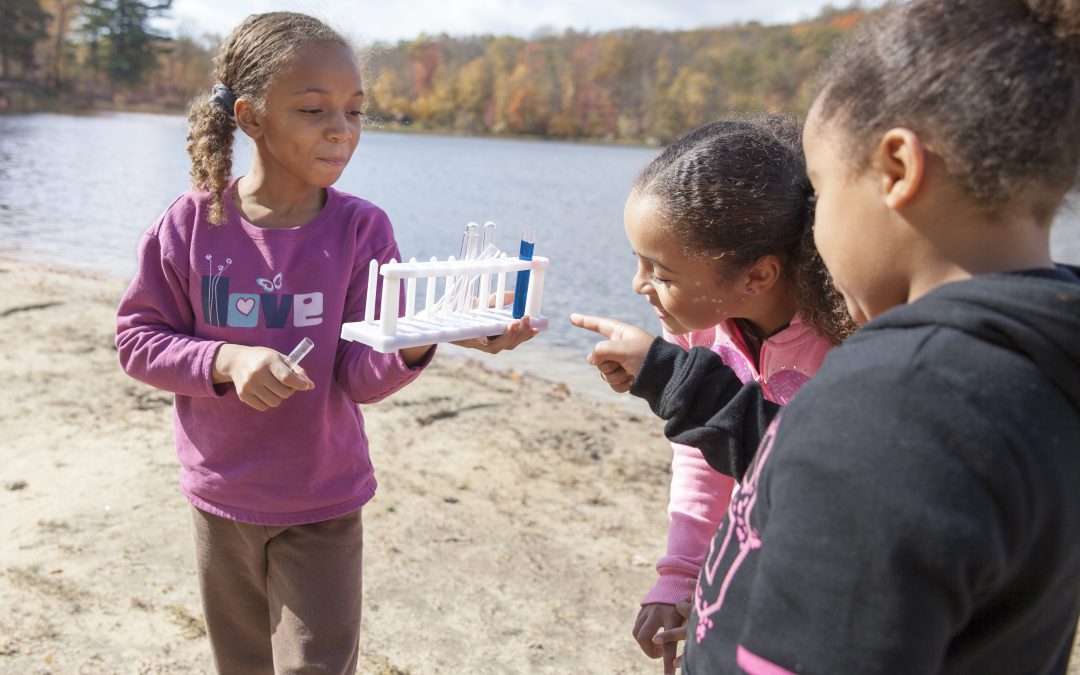Science, Technology, Engineering and Math: STEM pervades every aspect of our society, and is the engine of our future. Girl Scouts is committed to reducing the STEM gap by making sure girls feel supported and confident in exploring these exciting and important fields, despite the societal pressure, stereotypes, and obstacles they may encounter.
Pin this post for later!
GSUSA has been hard at work on this front: we’ve released tons of new badges, Journeys, and programs to help girls explore STEM fields. But what impact does this programming have? GSUSA’s four STEM Outcomes: STEM Interest, STEM Confidence, STEM Competence, and STEM Value describe how girls benefit when they participate in STEM programming. Each of these outcomes builds resilience and persistence in girls and helps them form life-long identities as scientists, innovators, engineers, and mathematicians.
The goal of these outcomes is simple: to let girls know that STEM is for them. Let’s decode the STEM Outcomes and see how leaders can encourage girls to explore and thrive in STEM.
STEM Interest
Girls learn that STEM is exciting and want to engage in STEM activities.
Spark your girls’ interest in STEM by introducing them to all the amazing fields of science that are out there to explore. Host a star party to get your girls dreaming of becoming an astrophysicist or astronaut. Introduce them to marine biology by doing experiments in and around the Bay so they can imagine themselves exploring the deep ocean. Watch them build robots, and envision what they might invent when they grow up. Teach them the basics of programming, and wonder how they might change the world. Head to our online Activity Finder and search keywords like “stem,” “science,” “engineering,” “environment,” or “astronomy” to find events and awards (such as the Think Like A Programmer Journey) that will let girls experiment with new interests and passions.
Pro Tip: We have many events that not only introduce girls to a STEM activity or field, but also will earn her awards, such as the Environmental Stewardship badges.
There’s even more scientific exploration to be had with our list of program partners; not only do they host amazing events, but places like the Children’s Creativity Museum or the Oakland Zoo or San Francisco Zoo make for excellent places to focus on STEM in your meetings.
STEM Confidence
Girls have confidence in their STEM skills and abilities.
Confidence is key to keeping girls in STEM. Child development studies show that as early as the second grade, kids agree that math is for boys, not girls, despite there being no difference in math and science abilities between the genders. Stereotypes like this damage girls’ interest in STEM, contributing to the lack of women in STEM fields. Use positive, encouraging language with the girls (and yourself!) when you try new activities, whether it’s playing with pH strips or identifying birds on a hike. Give girls specific feedback that encourages them to focus on their efforts and recognize their progress as they learn. “Yet” is a powerful word to remind girls that they can learn and build new skills: “I can’t do it… yet!” Emphasize that practice makes progress—not perfection.
To make your experiments a snap, check out a STEM Program Box! These kits come packed with easy-to-use curriculum and all the supplies your troop will need to earn a patch or badge. Girls can explore the STEM activities in a familiar and supportive troop environment.
STEM Competence
Girls think scientifically to solve problems.
Girls supporting girls is not only what Girl Scouts does, but it’s way to set girls up for success in STEM. It can be intimidating for adults to approach a STEM topic where we have very little prior knowledge, let alone for girls to try something potentially difficult and brand new. The STEM fields are diverse and complex, and scientists are constantly making new discoveries that influence our understanding of the world around us. But don’t be intimidated! More important than knowing the specifics of meiosis versus mitosis (the different ways cells divide and grow) or being able to recite the quadratic equation (x=(-b+/-√(b2-4ac))/2a) developing a scientific method of looking at the world is what girls need most. When you work with girls, encourage them to think critically and approach problem-solving with creativity and persistence. If you notice girls using a specific science skill, point it out to them. “I notice you’re making observations—that’s exactly what a scientist would do!”
Some other signs of “thinking like a scientist” are:
- Trying to understand the cause of a problem
- Gathering and carefully considering information from different places
- Making observations and predictions
- Communicating ideas and experiences
- Persisting through challenges
- Trying several ways to solve a problem
- Using reasoning and logic
Learning to think like a scientist is a journey, so why not start in on one of the new STEM Journeys from GSUSA! From computer programming to engineering to citizen science, these in-depth project series create pathways that open up entire realms of possibility for girls.
STEM Value
Girls learn the importance and relevance of STEM to people and society.
Learners are more connected and engaged when they are focused on a topic that is relevant to them. We all need to know that STEM is related to our everyday lives, and can help make the world a better place. Help make those connections for your girls by asking them about science they notice in everyday life: smartphones, cars, bridges, cooking… the list goes on and on! You might also ask for girls to share their prior knowledge about the science they encounter every day. With your guidance and support, they will make connections between the activities they’re doing, and real-world problem-solving. Even if they don’t choose science, technology, engineering, or math as a career, the STEM skills they learn in Girl Scouts will serve them in whatever career they choose, and will help them make informed and carefully considered choices as a citizen.
Whatever career path girls choose, the confidence, skills, and support they receive in our STEM programming will help them value who they are, and become who they want to be. Girl Scout CEO (and former rocket scientist) Sylvia Acevedo said, “Girl Scouts gave me that early confidence of being competent to…talk about what I deserve and not taking no for an answer.” Girl Scouts STEM programming isn’t rocket science—it’s just common sense.
Ready to get started? Check out these online resources:
- Don’t forget to check out GSNorCal’s own STEM page and review the four STEM Outcomes.
- Learn more about STEM programming at GSNorCal with our new online webinar series!
- For further reading, try Tips for Exploring STEM with Your Girl Scouts (No STEM Experience Required) on the Trailhead, or this STEM-tastic blog post about STEM and 21st Century Skills Your Girls Need from Girl Scouts River Valleys!
- And of course, don’t forget to explore the Activity Finder or The Guide for amazing STEM opportunities, and learn all about our new STEM badges and awards in the Volunteer Toolkit.
 Elspeth Kersh—Elspeth is a STEM Program Manager for Girl Scouts of Northern California, where she develops and supports all kinds of STEM experiences for girls. Before joining the Girl Scouts, Elspeth worked as an educator at the Lawrence Hall of Science and the Oakland Zoo. When she is not at the Girl Scouts office in Alameda, she can be found fishing with her husband, trying new recipes, and singing silly camp songs.
Elspeth Kersh—Elspeth is a STEM Program Manager for Girl Scouts of Northern California, where she develops and supports all kinds of STEM experiences for girls. Before joining the Girl Scouts, Elspeth worked as an educator at the Lawrence Hall of Science and the Oakland Zoo. When she is not at the Girl Scouts office in Alameda, she can be found fishing with her husband, trying new recipes, and singing silly camp songs.
 Jean Fahy, M.Ed—Jean is the STEM Program Director for Girl Scouts of Northern California, where she and her team partner with experts and volunteers throughout the council to offer unique STEM experiences to girls. She has taught math and science at elementary through high school and has spent many summers as Girl Scout Camp staff sharing her love of nature with girls. When she is not involved in Girl Scout activities, she loves to hike in the Oakland hills and camp in the Sierras with her family and dog, Tyler.
Jean Fahy, M.Ed—Jean is the STEM Program Director for Girl Scouts of Northern California, where she and her team partner with experts and volunteers throughout the council to offer unique STEM experiences to girls. She has taught math and science at elementary through high school and has spent many summers as Girl Scout Camp staff sharing her love of nature with girls. When she is not involved in Girl Scout activities, she loves to hike in the Oakland hills and camp in the Sierras with her family and dog, Tyler.


